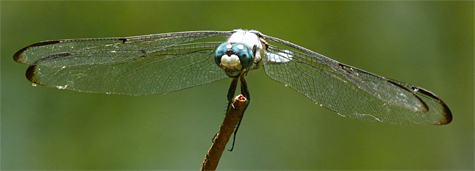
In order to help those of you who are interested in knowing what it is that you’re looking at when you see a dragonfly whiz by you as you stand on the boardwalk and paths that encircle the Wetlands here at the Museum, I’ve decide to offer up a quick and very simple identification guide. Here, we’ll start with two common odes (dragonflies) that could possibly be mistaken for one another.
Note: If you don’t care what the names of dragonflies are and just like to watch them fly around or sally forth from a perch on a rush stem, scroll down and look at the pictures, they’re quite nice.
Before starting, a little dragonfly anatomy would be helpful. Wait, wait, don’t go away. This won’t take long and it may help you later when I mention things like abdomen, frons, stigma…so hang in there for a moment.
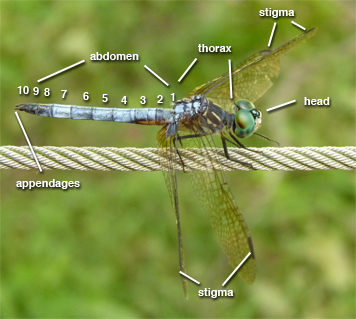
The stigma in each wing may vary in color from species to species, but are typically black. They either have to do with courtship or with wing stabilization. Studies have suggested both.
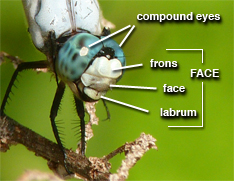
The numbers on the above photo indicate the individual abdominal segments. And, for our benefit, the observers, the shape and size of the appendages can be useful in determining the sex and identity of the dragonfly. For the dragonfly, the appendages are useful in reproduction.
.
On to the dragonflies.
Most of the dragonflies seen in our Wetlands are skimmers, the largest family of dragonflies. Most of them are generalists and can breed in a variety of ponds, swamps, and lakes. Just about any body of water you visit will have the same group of dragonflies as we have in our Wetlands, some will have more, some fewer. But, there’s a handful that can be found just about anywhere you roam in our area. That handful of odes is what this guide will concentrate on, at least for now.
Two common odes that are flying now are the Great Blue Skimmer and the Blue Dasher. Although they are both mostly blue, they are actually very different and can be easily separated.
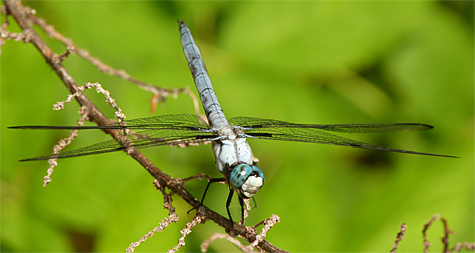
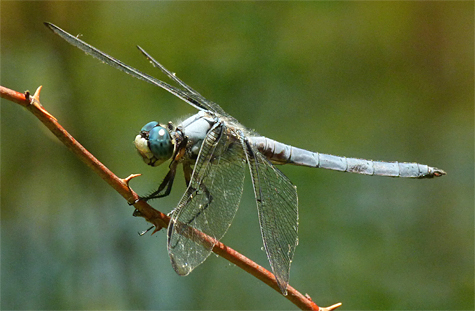
The photo at the top of the page is also a Great Blue Skimmer, note the dark edges to the wingtips.
The Blue Dasher (Pachydiplax longipennis) can hardly be missed if you visit either the Wetlands or the Sailboat Pond in Catch the Wind. It, like the Great Blue above, is mostly blue, but it’s only about 1.5″ long. That’s only about .75″ shorter than the big blue dragon. But when you’re talking insects, three quarters on an inch is significant.
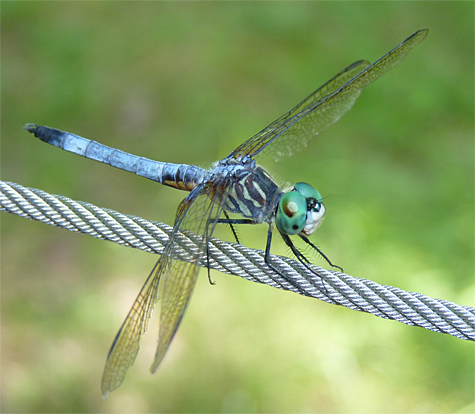
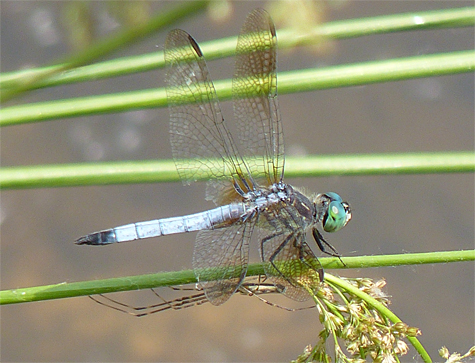
Both species like to perch on twigs and branches alongside the Wetlands and fly out to catch insects or chase away rivals, but the dashers tend to perch a bit lower than their bigger cousins. And remember, once you become familiar with them, the dasher’s smaller size will be more obvious to you.
The next time you’re around the Wetlands or the Sailboat Pond keep an eye out for these two dragonflies. You’ll see many more dashers than great blues at the Sailboat Pond but the numbers are fairly equal in the Wetlands, so compare as you walk around near the water’s edge.
That was easy, wasn’t it? Maybe a little too easy.
Oh, did I mention that the immature males and females of both of these dragonflies look much different than do the mature males. I think, though, that we’ll save that for another day. Besides, the females tend to stay up away from the water until it’s time to mate so you’ll see many more adult males flying around than you will females. And, you have to start somewhere. Get to know the males first.
Next time, two dragonflies that look nothing at all alike, both unmistakable in their own way.
Excellent article. It helped me identify a photo I took. Thank you!
Good, glad to be of assistance.
I have found a dragonfly that has antennae as long as it’s wings with little baubles at the top. It is seethrough and lacking colour on it’s body. It is about two and a half centremeters long. Any Idea’s?? Very unusual as I have never seen one before
Kylie,
Have you looked at owlflies as a possibilty? Dragonfly antennae are short and the only thing I can think of that may fit your description is an owlfly, except that the bodies are not necessarily “seethrough” or transparent. Look here: http://bugguide.net/node/view/4129
Good luck Kylie, and let me know if an owlfly is what you saw.